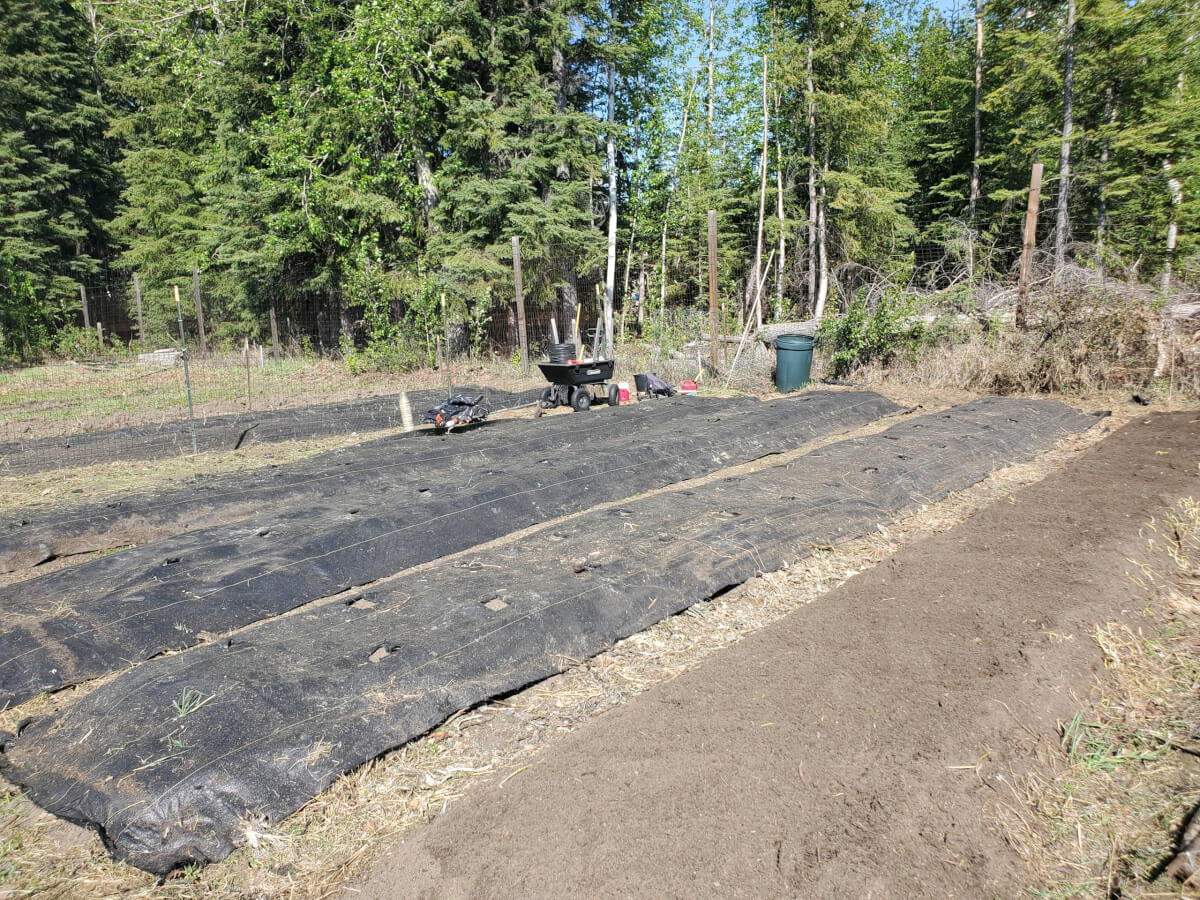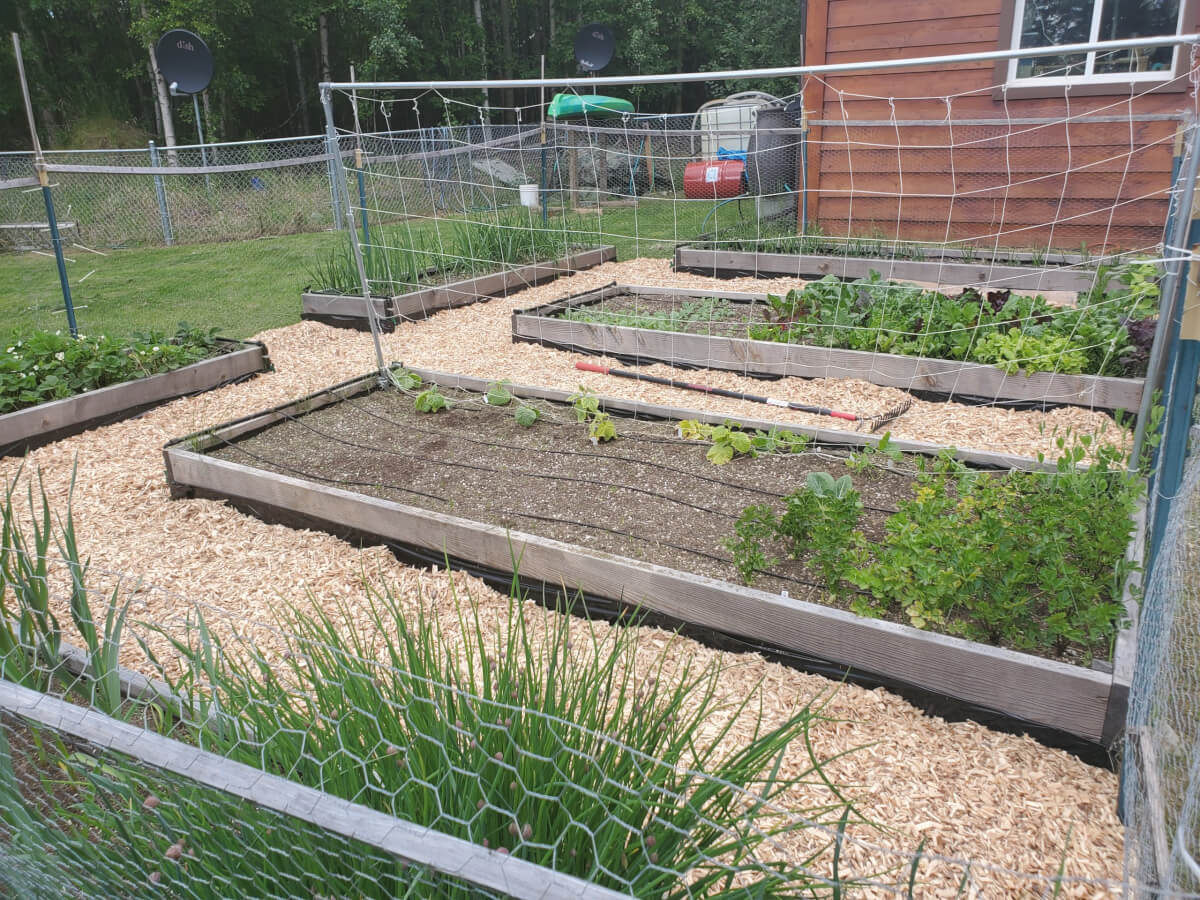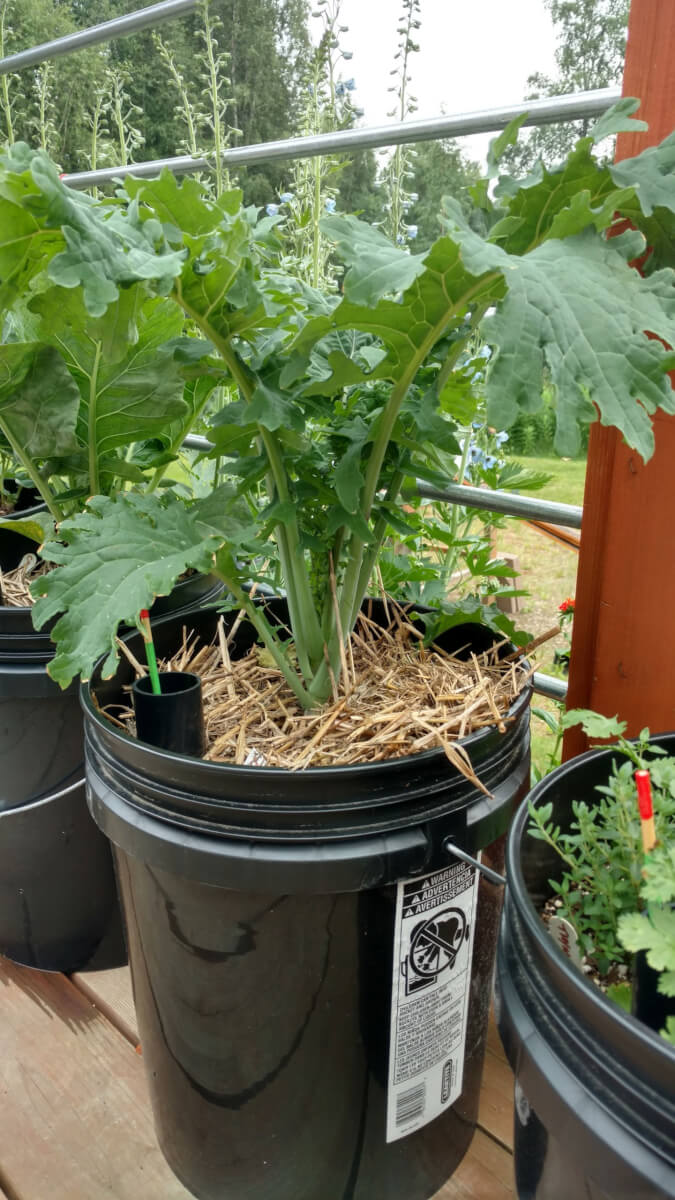We’re going to talk about garden mulch. We use this gardening technique a lot in our subarctic gardens and thus it deserves a section on our site.
Garden mulch is essentially any material that you place over your garden beds.
Using mulch is one of the best investments into your subarctic garden that you can possibly make.
Particularly here in the subarctic, mulch provides some superb benefits and is something every northern gardener should consider implementing.
What Are The Benefits Of Using Mulch?
Mulch features many properties, all of which are beneficial to the garden.
First and foremost, it can help with weed control. This will save a ton of time in garden maintenance through the garden season.
Another benefit is moisture retention. Mulch will help your soil retain moisture, which means you will not have to water as often. Your plants will be happier if they experience less drought conditions.
For us northern gardens, it will also help retain heat and allow the soil to warm up more quickly. This especially helps in northern soils, which are comparably cooler, which results in happy plants!

We frequently use weed fabric as a mulch. As you’ll learn further in this article, many different materials can be used as a mulch.
When it comes to subarctic growing, our research and experience has shown that mulch is critical to the health and success of many types of plants. Warm weather plants, such as tomatoes, peppers and cucumbers will greatly benefit from greater soil warmth and reward you with better harvests.
Lastly, mulch can often be an attractive addition to your garden. At a minimum, the reduction of weeds will certainly lend itself to making your garden more attractive overall.
What A Some Different Types Of Mulch You Can Use?
As me mentioned above, mulch is considered any type of material that you place over your garden beds.
There are several materials that can be used as mulches, all of which somewhat similar properties. Some of these other potential mulch materials include:
- Landscape fabric (also called weed fabric)
- IRT plastic (Infrared Transmitting plastic)
- Certified weed-free straw, or just straw
- Grass clippings (Free of weed seeds)
- Raw wood chippings
- Plastic/rubber chips (Generally not recommend due to being non-organic)
- Gravel or stones
- Newspaper (usually 4-8 sheets)
- Cardboard (typically 2-4 layers)
- Leaves, typically shredded
Any of these ingredients are suitable to use as mulches. There are some differences in longevity and maximum effectiveness, as you might imagine.
Nonetheless, all these options will provide more benefit than not having it at all.
When Is Mulch More Hassle Then It’s Worth?
We have found that mulch is not necessarily ideal in every garden. Sometimes, it’s better or easier to utilize other methods to get the desired results.
For smaller plants with high planting densities, you’re might be better off without a mulch.
Examples of these types of plants include leeks, green onions, radishes, carrots, beets, potatoes and other intensively planted foods where mulch would be less than effective.
Since we tend to plant these types of veggies quite intensively, we end up having to relieve the mulch in so many areas it just becomes less effective overall. Basically to a point where having mulch is more of an annoyance than having weeds.
In this case, the primary benefit of weed reduction is handled by the intensive planting techniques we like to use. Since our intentional plants tend to shade out and overcrowd weeds that might pop up, it is less likely weeds will take over.
In this case, the intensive planting provide the main benefits we are looking for. While not technically a mulch, it provides for some of the same results we’d typically use mulch for.
The Frosty Garden Way Of Garden Mulch
Our favorite mulch over the years has become landscape fabric, often times referred to as weed fabric.
Landscape fabric is typically permeable, meaning it allows water to seep through it and into the soil. This is generally a desirable characteristic as it allows water to get to your plants.
Landscape fabric is offered in rolls of varying widths and lengths to suit your particular garden application.
Applying it is relatively simple. You simply roll out the fabric and stake it down with garden stakes. To create a planting space, just cut an “X” into the fabric and plant your veggie or flower, tucking in the edges of the fabric.
We find landscape fabric to be exceptionally compatible with the wide raised rows that we utilize for our in-ground gardens. We can quickly and easily deploy the fabric and also shift the fabric between our rows for crop rotation purposes from year to year.
You can also apply the fabric to walking paths and access areas, which will greatly reduce the overall weeding you have to do.
Get The Right Stuff, The Good Stuff!
There are multiple levels of quality when it comes to landscape fabric.
Cheap stuff will quickly break down, usually within 2-3 years. While it’s somewhat effective, we’ve found it to be less than desirable as far as consistency and effectiveness.
Quality landscape fabric will last for a long time, sometimes rated for 10 to 25 years. Your exactly mileage may vary, but you can easily expect double the performance of cheap landscape fabric.
We have taken primarily to using the higher grades of landscape fabric. This is sometimes seen as “heavy duty” or “5 ounce” grade fabric.
We generally prefer the longer life span as it creates less waste for the environment and is also significantly more effective.
Unfortunately, we often have difficulties sourcing higher quality landscape fabric locally as most retailers tend to focus on the lesser quality fabric. We often have to order our landscape fabric online.
Cardboard Is An Effective Weed Deterrent!
When we wanted to finish out the walking paths for our raised beds, we strongly considered using weed fabric. It would have worked great and would also have been pretty easy.
We were interested in trying something different for this purpose.
Instead of our tried and true landscape fabric, we decided to experiment with cardboard. We could get away with cardboard as we intended to layer woodchips on top of them, making it basically invisible.

We saved up our cardboard for a good long while, allowing us to have sufficient quantities to cover our walking paths. It was a bit much, we had a cardboard mountain going for a little while there.
We layered down the cardboard in our raised beds. We typically layered about three layers of cardboard over the paths. Due to the variability of cardboard, sometimes we had more and probably sometimes less layers.
From there, we purchased a truckload of wood chips from one of our local wood suppliers. These aren’t terribly expensive, especially when you can self deliver.
We simply layered about 3 to 4 inches of wood chips on top of our layers of cardboard. We used 5 gallon buckets to deliver the wood chips into our raised bed garden.
It looks great from our perspective and you can’t even tell that it’s basically “trash” that is keeping things looking nice.
We’ve had very few problems with this technique and his has held up for many years. We have had some weeds come up in “nooks and crannies” where we probably failed to get adequate cardboard coverage, but this is easy to deal with.
Consider Using Mulch In Container Gardens
We’ve also found it helpful to use mulch in our container gardens.
One of the huge benefits of container gardens is the general weed situation to being with. They’re practically non-existent to begin with and easy to remove if they show up.
We like using mulch in our container gardens for the moisture conservation properties. Mulch allows for lesser evaporation of the moisture in your soil.

In this case, we used straw as our preferred mulch. It helps our containers retain moisture and also assists with preventing weeds from growing!
We find that with containers, the tendency towards evaporation of the moisture in your soil is magnified. Mulch will slow down that process, allowing greater efficiency of your watering efforts.
Our preferred mulch in containers is weed free straw. We like it because it’s easy to apply to container gardens compared to other solutions. Plus, it’ll easily compost back into the soil if some gets mixed in.
What Is This About IRT Plastic?
While IRT (infrared transmitting) plastic isn’t a material we personally use, it does have some popularity. Notably, the UAF Extension Service recommends its use when growing several types of plants in ground.
We can see why plastics might have superior insulative values and could even be more effective than landscape fabric as a weed deterrent.
Our primary reason for not trying this technique has been general availability. It’s difficult to source the material affordably in a place like Alaska, from our experience.
Plastic is not permeable. It would naturally restrict the ability for rain or a hose sprayer to properly irrigate your plants.
Thus, plastic mulch is always better suited to gardens where you have irrigation systems installed. You really need to get water right in your plant’s root zone to effectively make use of this technique.
Nothing Good Will Last Forever
We mentioned that we had a favorite type of mulch and have also experimented with other techniques.
A benefit of using organic mulches such as straw, paper, grass clippings and wood chips is they will compost over time. This can be especially valuable, especially if you have a desire to add nutrients back into your soils.
The thing with organic mulches is you have to continually replace them, at least if you want to retain the benefits. Since the material will eventually compost back into soil, you need to rebuild the mulch layers over time as well.
Sometimes this process can cause problems, especially if you have non-organic mulches underneath organic mulches.
For example, the main reason we used cardboard in our raised bed gardens was because we intended to cover it with wood chips. These chips would eventually break down into soil.
In this case, we didn’t want to have a non-organic layer of weed fabric underneath all this.
There might be reasons to use different types of mulch in different applications. Give some thought to your application, including the long term results as well.
Go Forth & Mulch Your Garden!
The mulch that you use is entirely up to you, but certainly think about using something in your gardens! It will save you many hours of time later and will result in happier plants.
We hope that you’ve found this article at least a little insightful, even though mulch is a fairly straight forward topic.
As always, if you want to chat about mulches, slap a comment down below!
That’s All We Wrote!

Having a good time? We have an ever growing list of insightful and helpful subarctic & cold climate gardening articles, waiting out there for you!
- Cold Climate Gardening Basics 👉
- Growing Your Garden From Seed Indoors 👉
- Advanced Cold Climate Gardening Techniques 👉
- Plant Specific Cold Climate Growing Guides 👉
- Subarctic Perennial Food Forests & Foraging 👉
- Indoor Garden Lighting & Grow Rooms 👉
- Greenhouses & Temperature Control 👉
- Harvesting & Food Preservation 👉
- Solving Cold Climate Garden Problems 👉
- 1 Minute Reads On Tons Of Garden Topics 👉
FrostyGarden.com is 100% ad-free and we do not use affiliate links! This resource is voluntarily supported by our readers. (Like YOU!) If we provided you value, would you consider supporting us?
